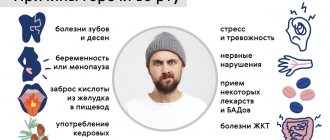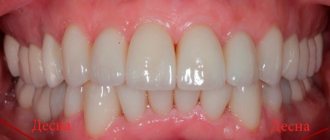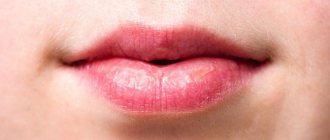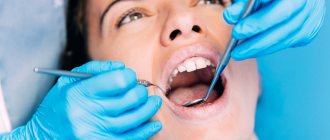Why does inflammation develop specifically on the lips? The fact is that the skin on them is different than on other parts of the body. The red border of the lips, although equipped with a protective stratum corneum, is too thin compared to the skin in other places. And at the same time, unlike the more secluded parts of the body, our tender and defenseless lips are always open to any adversity. They have to suffer from harsh climates, unfavorable ecology, chemicals contained in cosmetics, food, and many other irritants.
Related article: How to cure chapped lips? There are many reasons for cheilitis. Therefore, treatment may vary depending on the situation. But the first specialist you need to contact with such an ailment is a dentist. If it turns out that the disease is secondary, he will refer the patient to a specialized doctor.
To make it easier to navigate the variety of cheilitis, we will tell you about the main types of the disease.
Allergic to saxophone?
Did you buy a new lipstick or change your toothpaste? And suddenly my lips were “swept.” What's happened? This is how contact-allergic cheilitis manifests itself. The name itself speaks about the reasons that cause it.
But the culprits of the disease are not only chemicals - sometimes it develops after contact with metal objects. There is even a “professional version” - this type of cheilitis attacks musicians who play wind instruments - the lips react to contact with a metal mouthpiece. Peeling, itching, burning, redness of the lips, and sometimes swelling are unpleasant sensations. The main thing is not to try to get rid of them on your own; you can greatly worsen your condition.
What to do . To find and eliminate the culprit, this most often requires a consultation with an allergist and appropriate examinations to determine the allergen. For treatment, ointments containing corticosteroids, which have antiallergic, antipruritic and anti-inflammatory effects, are used, and antihistamines are also prescribed.
You will also have to watch your diet: give up citrus fruits, strawberries, chocolate, caviar and other foods that can provoke allergic reactions.
What it is
Cheilitis on the lips is a common phenomenon, however, most patients do not even suspect that damage to the mucous membrane and skin of the lips is a serious pathology.
Cheilitis is a disease associated with an inflammatory process that affects not only the mucous membrane, but also the red border of the lips. In addition, cheilitis is any abnormal change in the epithelial layer of the lips that occurs against the background of a serious disease of the internal organs or a sharp drop in immunity.
The location of the damaged areas may not be limited only to inflammation of the lip. In addition to dislocation on the upper and lower lip, as well as in the corners of the mouth (the so-called “angular cheilitis”), similar foci of inflammation can appear anywhere on the body, especially on the mucous membranes. The problem of damage specifically to the lip area is due to the fact that they are deprived of a protective layer, while they are constantly exposed to external negative influences, leading to overdrying, the formation of microcracks, and infections.
Wind and sun are not friends
There is also the so-called meteorological cheilitis, which often develops in those who spend a lot of time in the wind and are often exposed to sudden temperature changes in the air.
And in the southern regions, where the sun shines brightly almost all year round and therefore increases solar radiation, actinic cheilitis is common.
What to do. Lips should be well protected and constantly use hygienic and sun-protective lipstick. And for those who work in the wind, on the street, a special ointment based on lamb fat is suitable, which is no less effective than lipstick.
These two types of cheilitis must be treated promptly and carefully so that they do not gradually become chronic, because against their background, oncological diseases of the lips and oral cavity often rapidly develop.
Types of plaque on the lips in the morning
Experts say that a coated tongue and a slight coating in the mouth after a night's sleep is a normal phenomenon and is observed in both children and adult men and women. The norm is a thin layer of whitish plaque, through which the pink surface of the mucous membrane is visible. The smell may be weak or absent altogether. The film itself can be easily cleaned off with toothpaste during morning oral hygiene.
The pathology is a thick layer of plaque and its dark color (brown, gray), which is either not completely removed during cleaning or soon appears again. The same applies to bad breath.
Another crack?
A serious problem is a crack in the middle of the lip, which is very difficult to get rid of - the inflammatory process is “stimulated” by microbes that get into it, which prevents healing, and the lip in this place often bursts again and again. And this is not only a cosmetic flaw that spoils life - the crack causes pain when talking and eating. The disease can be triggered by injuries, lack of vitamins, smoking and meteorological factors.
What to do . First of all, find the reason that causes the crack to form again and again. And be patient to complete the course of treatment. The doctor will prescribe drugs that have an anti-inflammatory effect and accelerate the formation of epithelium at the site of injury. Sometimes antibiotics are needed.
In extremely difficult cases, they resort to excision of the crack. When the course of treatment is completed, it is important to ensure protection against relapse: use hygienic lipstick, forget about childhood habits: do not lick your lips, do not suck a pencil, do not bite your nails, give up spicy and too hot food.
Hormonal ointments for diathesis
A special group of local drugs used for diathesis are hormonal ointments. They are used if non-hormonal drugs do not help. Hormonal drugs have a more serious composition, including hormonal components - glucocorticoids. These are steroid hormones synthesized by the adrenal cortex. The most common among them are:
- Natural glucocorticoids: cortisol, hydrocortisone. Their effect lasts for 8-12 hours.
- Synthetic analogues: prednisolone, prednisone, methylprednisolone, mometasone, clobetasol. The substances act within 12-36 hours.
- Synthetic analogues containing fluoride: dexamethasone, betamethasone, paramethasone, fluprednisolone. The effect of the substances lasts up to 3 days.
Such substances have the following effects:
- Antiallergic. Hormones reduce the level of basophils - substances activated during allergies.
- Anti-inflammatory. Substances reduce the level of inflammatory mediators in the blood.
Hormonal drugs have a faster effect, but also have a more impressive list of side effects. For this reason, few hormonal ointments are approved for children, and they try to resort to them in extreme cases, when the child’s condition is advanced and he suffers from itching, large lesions and other unpleasant symptoms.
The list of hormonal drugs used for diathesis includes:
- Advantan (methylprednisolone) – from 4 months;
- Lokoid (hydrocortisone) – from 6 months;
- Afloderm (alclomethasone) – from 6 months;
- Beloderm (betamethasone) – from 6 months
- Dermovate (clobetasol) – from 1 year;
- Elokol (mometasone furoate) – from 2 years.
What are the dangers of using hormonal ointments for diathesis?
Because children have a larger surface area to weight ratio than adults, they are at greater risk for side effects from hormonal medications. With long-term use there is a risk of growth and development disorders. For this reason, children are prescribed minimal doses of ointments, as well as short courses. For example, Advantan cannot be used for longer than 4 weeks.
There are other features of the use of hormonal ointments associated with the small surface area of the child’s body. For example, Beloderm ointment is used very carefully and should never be applied under a diaper, since due to the increased absorption of the active components, the risk of developing serious side effects increases.
It is equally important to apply hormonal ointment with caution in the area of body folds. In these places, the ointment is absorbed more actively and can have a systemic effect on the body, that is, enter the bloodstream and influence from the inside.
In the case of hormonal ointments, it is also important:
- do not exceed the prescribed dosage;
- use the amount of ointment prescribed by the specialist;
- do not extend the period of use (in most cases no longer than 5 days);
- Apply only to the affected areas.
Continuous geography
Often, during an examination, the doctor asks: “Show your tongue!”: by its appearance, one can suspect symptoms of a variety of diseases. But the tongue also has its own specific diseases. One of them is desquamative glossitis, in which the surface layer of the mucous membrane begins to peel off, or, as experts say, slough off. As a result, in some areas of the tongue there are no filiform papillae left at all, and they acquire a bright red color, while a light coating appears on the neighboring ones.
What to do if a child has diathesis
Local therapy using ointments is one of the components of complex treatment. But both hormonal and non-hormonal drugs should be prescribed by a doctor individually for each baby, taking into account the characteristics of the diathesis.
Self-medication in such a situation is not only ineffective, but also dangerous for the child’s health. Therefore, it is better to contact competent specialists. PsorMak employs doctors with extensive experience in treating diathesis.
We take a comprehensive approach to diagnosis and treatment, and for local therapy we use ointment made according to our own recipe without the addition of hormones.
She has been helping our patients at our clinic for more than 25 years, so we guarantee a complete cure without side effects. Contact us for a consultation so we can begin solving your problem. April 5, 2020
Author of the article: dermatologist Mak Vladimir Fedorovich
If hair grows in your mouth
Of course, this does not happen, but sometimes it seems that the tongue is covered with... hair. The fact is that thread-like papillae grow on the tongue, and their length can reach one and a half centimeters, and they become like hairs. This phenomenon is observed in cases of impaired immunity, in response to certain medications that disrupt the microflora of the oral cavity, as well as in patients with chronic gastritis and colitis. There is nothing wrong with this, but the patient experiences unpleasant sensations that create constant discomfort.
What to do . If possible, you should stop taking medications and take only antihistamines. After 5–10 days, the “hair” on the tongue will disappear. And don’t forget to brush not only your teeth, but also your tongue twice a day.
Fungal
Reason . Fungal infection Candida albicans. Damage to the red border of the lips is often combined with stomatitis. The disease is promoted by poor oral hygiene, hypovitaminosis B2, long-term use of antibiotics or glucocorticoids, poor nutrition (little protein foods, too many carbohydrates), as well as carbohydrate metabolism disorders.
Symptoms . The lips are swollen, reddened, the edges of the lips are dry and flaky. In the corners of the mouth there are weeping areas with erosions covered with a whitish, easily removable coating.
Treatment and prevention . First, you need to test for a fungal infection. If its presence is confirmed, the doctor will prescribe antifungal drugs, which should be used orally in combination with vitamin B2 and ascorbic acid. Complete sanitation of the oral cavity and careful treatment of problem areas with oil solutions of vitamins are necessary. To prevent relapses, a diet with limited carbohydrates is prescribed.
Be careful, border!
Oncological diseases of the lips and oral cavity usually creep up unnoticed; all of them can now be successfully treated if you consult a doctor in time. What symptoms should you pay attention to?
Sometimes a malignant formation can cause a harmless-looking spot on the lip. Although it often does not bother you for several months, then an erosion or ulcer suddenly forms, which seems to sink inside the lip and harden.
In men after forty years of age, a wart often appears on the lip, which quickly becomes covered with papillae, becomes horny and lasts for 4–6 months. It is best to remove it as soon as possible.
In general, if you feel any discomfort in your mouth or notice something “suspicious,” do not put off visiting the dentist. Be attentive to yourself!
Meteorological
Reason . Exposure to cold air, strong wind. It occurs more often in men, especially those who suffer from general weather sensitivity or work outdoors.
Symptoms . Peeling, itching and dryness, as well as erosions and crusts on the lips. Cracks in the corners of the mouth.
Treatment and prevention. If possible, minimize exposure to cold and wind. Use protective cosmetics for lips. Take B vitamins internally, as well as PP. Use special wound-healing ointments externally and often rinse your mouth with extracts of chamomile, oak bark, and calendula.
Herpes on the nose: causes of manifestation and exacerbation
As with herpes on the lips, manifestations in the nasal area are caused by viruses of types 1 and 2. The infection may go unnoticed and appear weeks or even months later.
Typically, an exacerbation of infection is provoked by the following circumstances:
- overheating (on the beach in summer) or hypothermia;
- viral or bacterial diseases;
- unbalanced diet;
- stress, destructive situations;
- alcohol abuse, smoking;
- lack of vitamins;
- exacerbation of chronic diseases;
- long course of antibiotics;
- Women may experience infection during menstruation.











